When visiting Vietnam, you might feel unfamiliar with a coffee type called “Weasel Coffee.” Let Hello 5 Coffee explain this special coffee variety through the article below.
Overview of Vietnamese Weasel Coffee
From primitive plantations to professional farms, Vietnamese weasel coffee has gradually established its position in the eyes of both domestic and international consumers.
Understanding the Concept of “Weasel Coffee”
Weasel coffee (English names: Civet Coffee or Kopi Luwak) is a special coffee variety processed from coffee beans that Asian palm civets have consumed and excreted. This represents one of the most expensive and rare coffee types worldwide. Vietnamese coffee weasel gains global recognition through its unique production process and distinctive flavor profile.

The term “weasel” comes from the Vietnamese word “chồn,” referring to the Asian palm civet (Paradoxurus hermaphroditus), a small mammal that plays a crucial role in creating this extraordinary coffee. When these animals consume ripe coffee cherries, they digest the fruit’s flesh while the beans pass through their digestive system, undergoing a natural fermentation process that transforms the coffee’s chemical composition.
The Weasel Coffee Production Process
To obtain aromatic weasel coffee beans with distinctive characteristics, we follow a production process consisting of several steps:
1. Civet Selection of Coffee Cherries
This marks the initial step in the entire weasel coffee creation process. Vietnam Coffee weasel begins with harvesting ripe, disease-free fruits. Asian palm civets demonstrate remarkable selectivity, typically choosing only 20% of the ripest, highest-quality coffee cherries. Through this natural selection process, the beans undergo screening that humans cannot replicate.
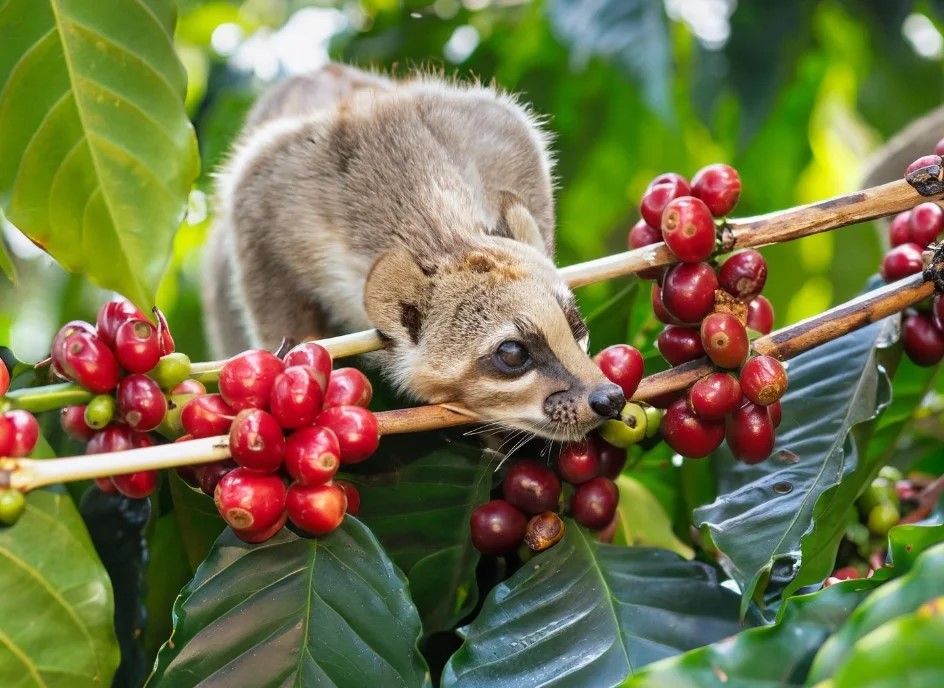
2. Digestion and Fermentation Within the Civet’s Body
When civets consume coffee cherries, they digest the fruit’s flesh while the coffee beans (seeds) pass through their digestive system. During this process, enzymes in the civet’s stomach interact with proteins in the coffee beans, reducing bitterness and enhancing flavor complexity.
3. Excretion and Processing
After civets excrete the waste, producers collect the coffee beans, wash them thoroughly, dry them, and roast them like conventional coffee. The beans undergo intensive washing under water pressure to remove husks, impurities, and bacteria. At this stage, the coffee beans have undergone biological transformations that create their characteristic aroma and flavor.
4. Drying and Stabilization
After initial processing, the beans are dried under natural sunlight until moisture content reaches approximately 11-12%. Subsequently, the beans are stored in sealed warehouses for at least 7-10 days to allow flavors to harmonize and stabilize before roasting.
The coffee parchment excreted by civets requires drying under natural tree shade for approximately 3 months before collection. Creating “artificial weasel coffee” products through forced methods such as feeding civets unripe coffee fruits, including immature fruits, immediately collecting and washing civet-excreted beans and drying them in direct sunlight, and maintaining unsanitary breeding conditions cannot produce authentic, natural weasel coffee products.
5. Parchment Removal and Manual Roasting
After drying, beans undergo parchment removal to reveal the green coffee beans. The manual roasting process at controlled temperatures preserves maximum enzyme essence and natural aroma of weasel coffee, creating fine powder with the characteristic cockroach-wing brown color.
6. Brewing and Tasting
Vietnamese coffee weasel is typically brewed using traditional aluminum filters (phin) or espresso machines. The finished product offers smooth texture, minimal acidity, lasting sweetness, and characteristic glossy crema. Each cup provides a unique, unforgettable experience for coffee connoisseurs.

Distinguishing Between Natural and Artificial Weasel Coffee
With scientific and technological development, artificial weasel coffee has been created. Harvesting natural weasel coffee often involves negative impacts on wild civets (hunting, captivity, forced feeding) and ecological imbalance. Meanwhile, artificial weasel coffee doesn’t involve animals, contributing to civet welfare protection and environmental conservation. Below are differences between natural and artificial weasel coffee.
Natural Weasel Coffee
Natural weasel coffee (kopi luwak) is processed from ripe coffee beans that Asian palm civets have consumed and partially digested, then collected from civet feces, cleaned, dried, and roasted into finished products.
Worldwide, many different civet species exist, but only Asian palm civets and masked palm civets consume coffee fruits and excrete intact beans. In Vietnam, when initially encountering the processing method, people couldn’t distinguish the biological characteristics of these two species, resulting in inconsistent product quality.
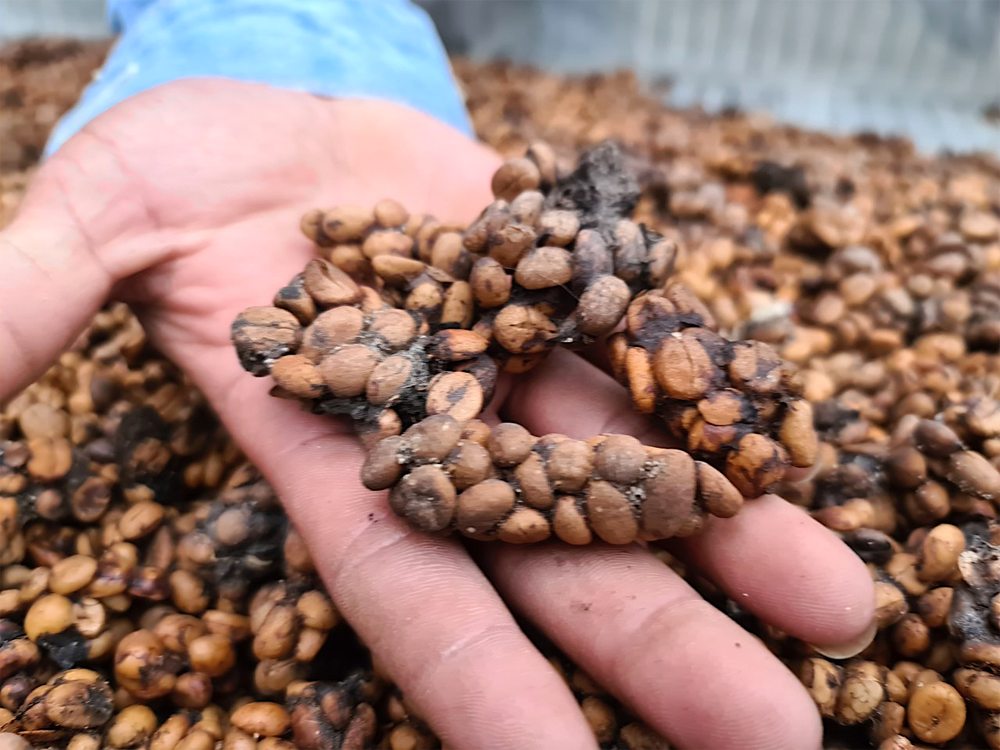
The issue stems from masked palm civets, which possess strong jaws that crack beans when eating coffee fruits. Additionally, this species’ feces has an extremely unpleasant odor, affecting weasel coffee flavor. Conversely, Asian palm civets excrete intact coffee beans. Asian palm civet coffee, after roasting and grinding, becomes extremely aromatic and flavorful, without overpowering scent but possessing special allure.
The digestive process in civet stomachs allows enzymes and microorganisms to break down proteins, reducing bitterness and creating complex aromatic compounds that are rare due to complete dependence on wild civet feeding habits.
Natural weasel coffee flavor typically presents smoothness, minimal acidity and bitterness, lasting sweetness, with notes of chocolate, ripe fruit, and earthy undertones, creating unique, unforgettable experiences.
Artificial Weasel Coffee
Artificial weasel coffee represents a biological fermentation product using isolated and cultivated microorganisms or enzymes to simulate civets’ natural digestive process without involving actual civets.
In this method, clean coffee beans are fermented with enzymes or microorganism mixtures at approximately 37°C for 24-48 hours, then washed, dried, and roasted according to standards, aiming to recreate chemical changes similar to natural civet digestion.
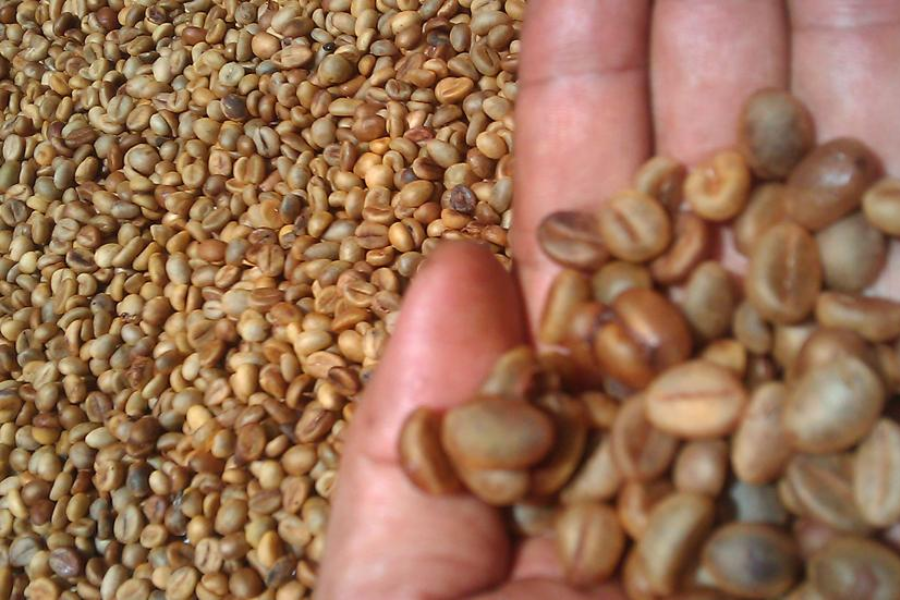
Compared to natural varieties, artificial coffee can be produced more consistently in quantity and at lower costs due to completely controlled factory processes, while ensuring better food safety and hygiene.
Origin and Development of Weasel Coffee in Vietnam
Weasel coffee appeared in Southeast Asia, including Indonesia, Philippines, Malaysia, and Vietnam, from the 18th-19th centuries through indigenous people’s discovery of different flavors in beans after natural civet digestion.
Historical Formation and Development in Vietnam
In Vietnam, weasel coffee is primarily known in the Central Highlands region, where wild Asian palm civets climb coffee trees seeking ripe fruits. This represents the natural beginning of Vietnamese weasel coffee, completely dependent on indigenous coffee forest ecosystems and civet feeding habits.
In the late 19th century, during French colonial period, coffee was first introduced by the French for experimental cultivation in South Central Vietnam and the Central Highlands. In pristine forest areas, civets (Paradoxurus spp.) naturally consumed ripe fruits, digested them through stomach enzymes, then excreted beans. Local people accidentally collected and processed these beans, discovering unique flavors with reduced acidity and bitterness compared to regular coffee.
During the early decades of the 20th century, weasel coffee was truly known only as legend, appearing sporadically in hillside gardens. The French documented civets in Java forests (Indonesia) consuming coffee fruits long ago, but only in the mid-20th century did this spread to Buon Ma Thuot and Da Lat forests. Weasel coffee wasn’t commercialized, serving only connoisseurs in some French-style villas in Da Lat. Natural production remained extremely low, with harvesting dependent and difficult to control, making it expensive but circulated only as a “secret” beverage for officials and upper classes.
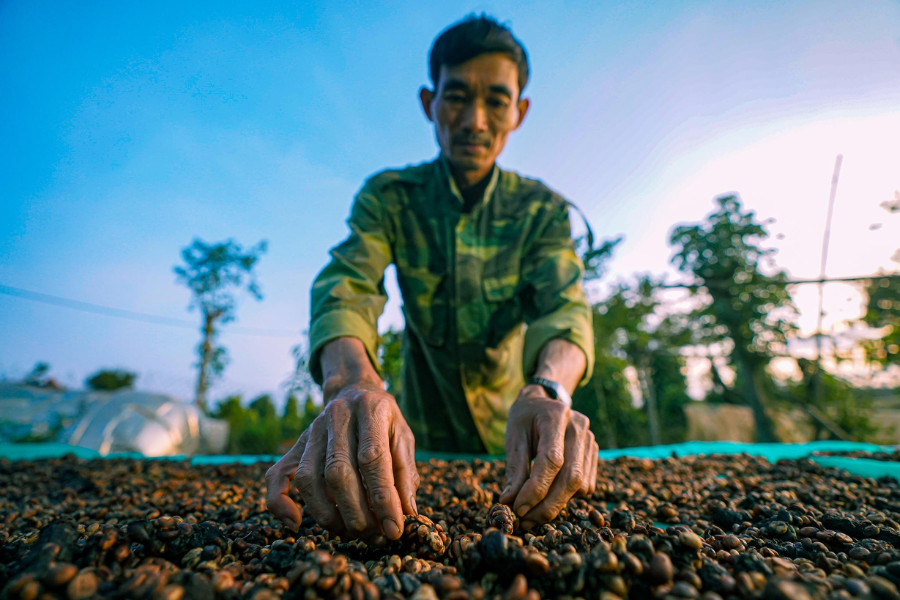
After the Renovation period, international tourists began seeking indigenous coffee cultural experiences. Some Central Highlands farmers began more standardized exploitation: allowing civets to eat ripe fruits directly in gardens and collecting separate feces, called “semi-wild breeding.” The first weasel coffee cooperative was established in Lam Dong, providing technical support for harvesting, processing, and roasting. This gradually stabilized quality, and Vietnamese weasel coffee began attracting tourist attention.
In the early 2000s, numerous professional weasel coffee brands partnered with farms, expanded production scale, and built modern processing lines. Coffee shops in Hanoi, Ho Chi Minh City, and Da Lat proliferated menus featuring “mulberry weasel coffee” and “arabica weasel coffee” for experimental service. Customers could witness civets eating, processing, and roasting firsthand. Domestic and export markets gradually developed: weasel coffee became a distinctive tourism product and premium gift. Prices per kilogram could reach tens of millions of dong.
Famous Vietnamese Weasel Coffee Growing Regions
Vietnam possesses numerous highlands and mountainous regions with diverse soil and climate conditions. Famous weasel coffee growing areas concentrate in the Central Highlands, Lam Dong Plateau, Northwest region, and some new locations in South Central Vietnam.
1. Dak Lak and Gia Lai
Dak Lak is dubbed Vietnam’s “coffee capital” with elevations of 400-800m, distinct dry seasons, and nutrient-rich basalt soil. This region suits both Robusta and Arabica weasel coffee, creating rich, nutty flavors with creamy aftertastes. Adjacent Gia Lai also primarily grows Robusta weasel coffee. Semi-wild civet farms allow natural roaming in coffee gardens, ensuring stable bean quality with mild bitterness harmonizing with highland forest characteristics.
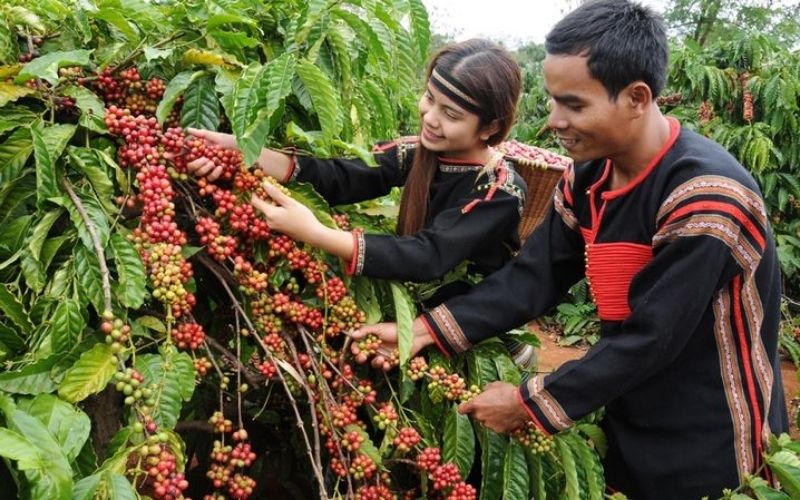
2. Lam Dong – Da Lat
Lam Dong Plateau at 800-1,500m elevation features year-round temperate climate, frequent fog, and fertile red soil. These conditions ideally suit Arabica weasel coffee development, producing gentle fruit aromas, sweet aftertastes, and delicately balanced acidity. Many farms open to tourists for experiencing civet feeding, feces collection, processing, and on-site roasting, elevating weasel coffee to distinctive tourism products.
3. Son La
Son La at 800-1,200m elevation with diverse soil and highland tropical climate produces Arabica weasel coffee with gentle aroma, fresh acidic taste, and rich sweetness, highly rated in domestic and export markets. Semi-wild civet breeding models combined with cooperatives help farmers coordinate purchasing, stabilize quality and prices.
4. Quang Tri
Though not as famous as the Central Highlands, Quang Tri’s hills at 300-500m elevation with red basalt soil and monsoon climate offer potential for Arabica weasel coffee, especially Catimor varieties. Local weasel coffee products present balanced flavor between acidity and bitterness, offering novel sensations compared to northern highlands or Central Highlands regions.
Outstanding Characteristics of Vietnamese Weasel Coffee
Vietnamese weasel coffee leaves its mark through complex flavors, high nutritional value, and unique irreplicable processing methods. Extremely limited production and expensive prices further enhance its “royal” status.
Distinctive Flavor Profile
Weasel coffee possesses complex aromas combining earth, wood, chocolate, caramel, and dried fruit notes, creating depth that spreads immediately upon first smell. Natural sweetness, smooth texture, minimal acidity and bitterness; lasting aftertaste makes each sip leave unforgettable impressions. The biological fermentation process in civet stomachs breaks down bitter proteins while releasing amino acids and simple sugars that increase sweetness and bean smoothness.

Nutritional Value
Weasel coffee contains high levels of antioxidants (chlorogenic acid, polyphenols, melanoidins) that protect cells and reduce cardiovascular disease and diabetes risks. Chlorogenic acid in weasel coffee decreases significantly compared to regular coffee, making it stomach-friendly and reducing digestive irritation. Additionally, natural caffeine supports concentration and mental enhancement; biological peptides from civet intestinal enzymes may improve memory (under research).
Differences from Other Coffee Types
- Processing Method: Weasel coffee beans undergo natural fermentation in civet stomachs combined with specific enzymes, impossible to replicate with conventional coffee processing methods.
- Production Volume: Harvest yields are extremely limited (natural or semi-wild breeding), resulting in prices 50-100 times higher than regular coffee.
- Flavor & Molecular Structure: After fermentation, bean chemical structure changes, creating softer, smoother shells with perfectly balanced ratios of sugars, acids, and proteins compared to conventional Arabica or Robusta.
| Criteria | Vietnamese Weasel Coffee | Regular Coffee |
|---|---|---|
| Processing Method | Biological fermentation in civet stomach | Standard wet/dry fermentation |
| Flavor | Complex, smooth, low acidity, lasting finish | Diverse by variety, may be bitter or acidic |
| Production | Extremely limited, selective harvesting | Large-scale industrial production |
| Price | Very high (natural 30-60 million VND/kg) | Typical 300-500 thousand VND/kg |
| Replicability | Cannot be industrially reproduced | Standardized, stable processes |
Vietnamese Weasel Coffee Prices and Reasons for High Cost
Due to complex, rare, and manual processes, this coffee type sells at many times higher prices than regular coffee.
Average Market Prices
Naturally harvested weasel coffee prices range from 3-10 million VND/kg. Meanwhile, “artificial” weasel coffee (enzyme simulation) costs less, only hundreds of thousands of VND/kg, because this coffee type doesn’t undergo actual civet digestion.
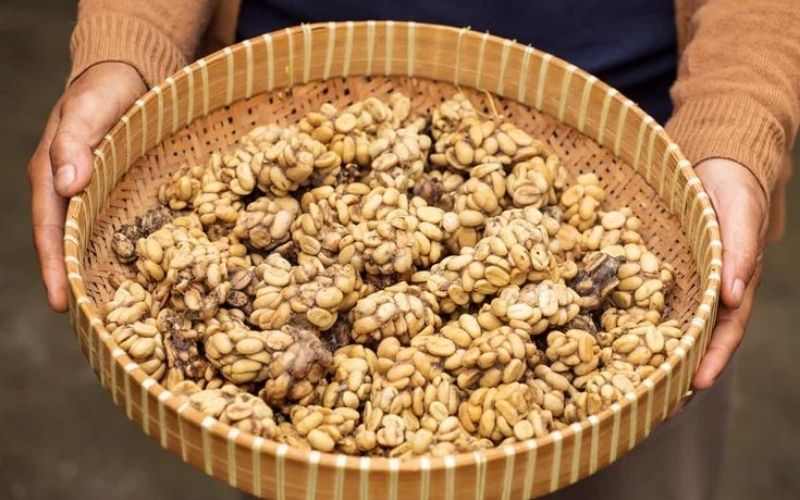
Factors Affecting Prices
Multiple factors make weasel coffee prices much higher than regular coffee types:
- Limited Supply: Asian palm civets only produce a few hundred grams of beans annually, easily becoming ill if confined; natural exploitation becomes even rarer.
- Complex, Manual Processes: Collecting civet feces, cleaning, drying, careful shell removal, and meticulous roasting are all done by hand.
- Unique Flavor: Civet stomach enzymes break down bitter proteins, increase sweetness, and create delicate chocolate, caramel, and fruit layers.
- Safety Requirements and Origin Traceability: Requires closed supply chains, ensuring hygiene without adulteration or contamination.
- Branding and Experience: Many roasters attach stories and serve “try while witnessing civet eating” experiences, adding tourism value and premium gift pricing.
Where to Buy Authentic Vietnamese Weasel Coffee
Vietnam is famous for premium weasel coffee lines, combining unique biological fermentation processes with artisanal processing skills.
5 Reputable Vietnamese Weasel Coffee Brands
Below are 5 representative brands, highly rated for quality, flavor, and tasting experiences:
1. Trung Nguyen Legend Weasel Coffee
Weasel coffee represents Trung Nguyen Corporation’s premium product. The company has applied biotechnology simulating civet stomach fermentation, ensuring authentic natural civet beans. Products are luxuriously packaged, with 225g boxes priced at approximately 350,000 VND.
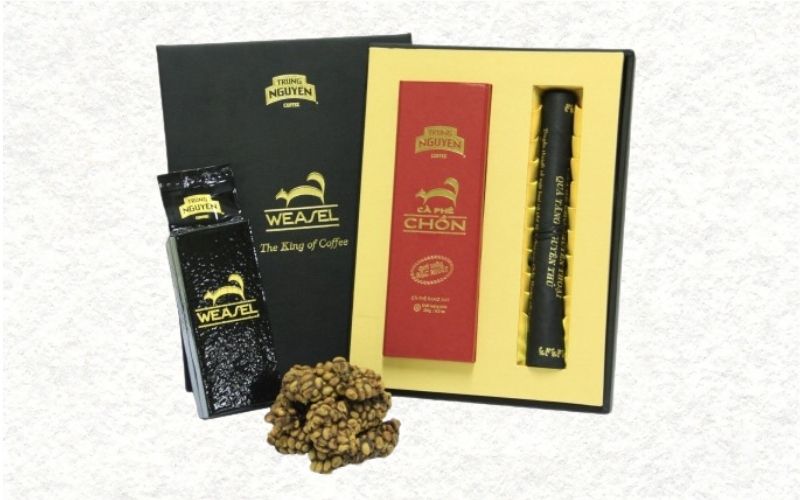
2. Mr.VIET Weasel Coffee
This brand offers premium Arabica civet beans hand-harvested from highland regions. Modern processing methods combined with strict quality control from farms. 200g packages cost approximately 250,000 VND.
3. Me Trang Weasel Coffee
This brand’s natural Robusta civet beans come from Buon Ma Thuot. They undergo biological fermentation in civet stomachs, featuring wood smoke aromas blended with chocolate and mild bitter aftertastes. 250g packages cost approximately 350,000 VND.
4. Napoli Weasel Coffee
This brand’s weasel coffee line artfully blends Italian style with Vietnamese civet processes. Smooth flavors feature chocolate-hazelnut-caramel layered aromas. 200g packages cost approximately 280,000 VND.
5. Hello 5 Coffee Global
Hello 5 Coffee Global‘s main product lines include Arabica-Robusta coffee beans, roasted ground coffee, weasel coffee, filter coffee, and instant coffee. Hello 5’s strength lies in its closed supply chain from farm to factory with 150 tons/month roasting capacity, strict quality control processes meeting Halal, HACCP, ISO, and FDA standards, plus customizable roasting profiles and packaging to meet diverse domestic and international partner needs, with export networks spanning Europe, North America, Japan, and South Korea.
Tips for Distinguishing Authentic vs. Fake Weasel Coffee
Weasel coffee is precious “black gold,” but markets feature many counterfeit products or chemical adulterations. Distinguishing authentic from fake products protects health and consumer rights while maintaining Vietnamese weasel coffee industry reputation.
- Check Origin and Packaging: Prioritize purchasing from reputable brands with “semi-wild breeding” or natural harvesting certifications. Genuine packaging clearly states origin, production dates, expiration dates, and quality certifications.
- Avoid Unusually Cheap Products: Authentic weasel coffee has high input costs, typically priced from tens of millions of VND/kg upward. Prices of only hundreds of thousands may indicate counterfeits or chemically flavored products.
- Observe Coffee Beans: Authentic beans are uniform in size, cockroach-wing brown or light brown color, smooth glossy surfaces, few broken pieces, no dust or impurities. Fake beans have uneven coloring, possibly blackish or abnormally dull, rough surfaces, peeling shells, easily crumbling when touched.
- Check Aroma: Authentic weasel coffee has complex aromas blending fruit, chocolate, caramel, and light wood scents without harsh chemical odors. Counterfeits often smell strong, sourly sharp, or slightly off, sometimes with chemical marinade odors to “fake” natural civet aromas.
- Taste and Texture Testing: When tasting, authentic weasel coffee has smooth sweetness, mild bitterness, very little acidity, lasting aftertastes, and warming throat sensations. Fake coffee typically tastes bland, sometimes harsh or sourly sharp, lacking roundness and characteristic sweet aftertastes of authentic weasel coffee.
- Observe During Brewing: Filter or manual brewing: authentic coffee produces light crema (fine foam) on surfaces, clear brown color, moderate consistency; when settled, almost completely dissolves with little sediment. Fake coffee may produce less durable crema, cloudy water, sediment deposits, and darker color when brewed with identical methods.

Ethical Issues in Weasel Coffee Production Industry
From natural coffee, the industry has artificially created caged civet coffee with increasing production, bringing numerous ethical problems. Caged civets are typically confined in cramped cages with just enough room to stand and turn around, causing long-term stress. Forced feeding regimens of monotonous coffee fruits cause fiber and natural digestive enzyme deficiencies, leading to malnutrition or obesity. Additionally, poor sanitary breeding conditions, lack of clean water, and exercise space increase disease risks, reduce lifespans, and cause abnormal behaviors in caged civets.
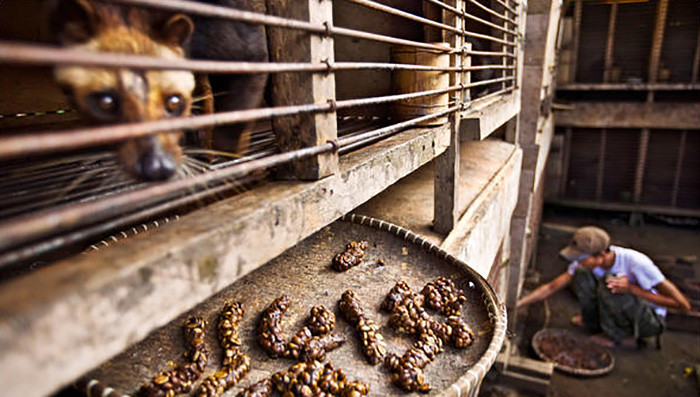
High artificial demand drives illegal wild civet hunting, depleting natural populations. When caged, civets cannot return to natural habitats, affecting indigenous ecological balance. Wildlife capture eliminates important roles in food chains and pristine forest biodiversity. For sustainable development, government, business, and consumer involvement is needed for monitoring, certification, and promoting breeding models that respect animal rights and community interests.
Vietnamese weasel coffee has experienced many historical turning points. This product is not merely a beverage but also bridges indigenous culture, tourism, and international preferences. Looking toward the future, the challenge is maintaining complete natural essence while ensuring social and environmental responsibility so weasel coffee continues being Vietnamese coffee industry pride.
Contact us – Hello 5 Coffee – No.1 Vietnam Coffee Manufacturer, Exporter & Supplier
- Email: info@hello5coffee.com
- Phone: (+84) 81 535 5505
- Head office: No. 73, To Hien Thanh Street, Phuc La Ward, Ha Dong District, Hanoi City.
